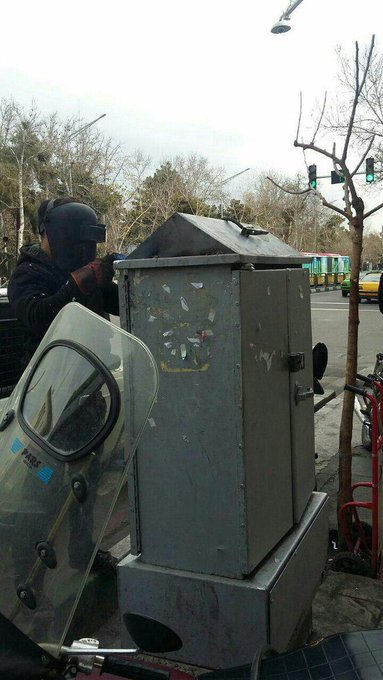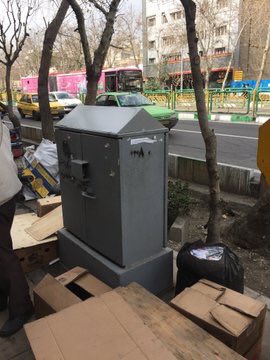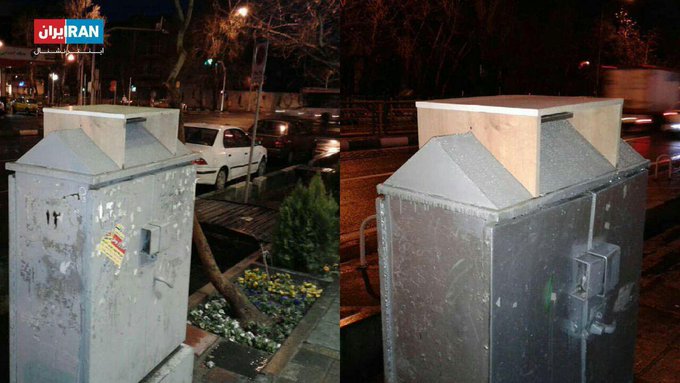
Before the end of 2017, women in Iran began to publicly express their rejection of the Islamic Republic's policy of dictating what women should wear.
At a time when Iran was witnessing protests against poor living conditions, high prices of basic materials and demonstrations against Tehran's foreign policy and interference in regional conflicts at the expense of the well-being of the citizen, women found the opportunity to speak about the headscarf that the authorities required to wear and punish noncompliance with the instructions.
The method of protest was the same in cities where hundreds of young women, including older women, crossed the telephone boxes. But in an attempt to clear the "phenomenon" of taking off their headscarves in front of the public using telephone boxes, the authorities worked to put a triangular wooden base on top of those boxes to prevent the protesters from receiving them.
21 Feb
Heshmat Alavi
@HeshmatAlavi
Replying to @HeshmatAlavi
#BREAKING
Feb 21 - Tehran, #Iran
Another #GirlOfEnghelabStreet was arrested today after bravely protesting compulsory #hijab laws. # IranProtests pic.twitter.com/vzorMlWpmD
Heshmat Alavi
@HeshmatAlavi
Tehran, #Iran
This is how terrified authorities are of brave women climbing utility boxes & taking off their headscarves to protest compulsory #hijab.
Welding a sloped roof on the utility box to prevent anyone from standing on top of it. # GirlsOfRevolutionStreet # IranProtests pic.twitter.com/R2UipDXZU0
12:45 PM - Feb 22, 2018
View image on Twitter
69
80 people are talking about this
Twitter Ads info and privacy
View image on TwitterView image on Twitter
Fereshteh Sadegh
@fresh_sadegh
Islamic Republic has a strange talent to delete questions rather than finding solutions for them, so they reshape power box used by some girls to show their approval of #Hijab. #Iran
1:20 PM - Feb 22, 2018
41
32 people are talking about this
Twitter Ads info and privacy
But the protest against the obligatory headscarf seems to refuse to bow to the wishes of the government. The Iranians, in turn, devised a wooden base placed on top of the triangle set up by the authorities, allowing not only to stand on phone boxes but at higher altitudes.
25 Feb
ALI
@ AliSalari1965
Replying to @ AliSalari1965
Well-known Iranian human rights lawyer Nasrin Sotoudeh reports anti-compulsory hijab protester #ShaparakShajarizadeh (arrested on Wed) has unwillingly been sentenced 2 unknown medical shots while in prison. Her family's concerned about her wellbeing. At least 3prisoners have died pic.twitter.com/pISdzxKg6P
ALI
@ AliSalari1965
#Iran Action Iranian time to welding All sloped roof on the utility box to prevent anyone from standing on top of it.
But this image shows New way women's for the time for recapture
utility boxes and protest against forced # hijab. # No2ForcedHijab #FreeIran pic.twitter.com/pNYS4f6Kcf
1:53 PM - Feb 25, 2018
4
See ALI's other Tweets
Twitter Ads info and privacy
25 Feb
Heshmat Alavi
@HeshmatAlavi
Replying to @HeshmatAlavi
Feb 23 - Isfahan, central #Iran
Friday prayer imam says #GirlsOfRevolutionStreet demonstrating compulsory #hijab are "hypocrites" & worse than "disbelievers."
He calls for repressive measures, saying they should be arrested & not easily released.
More reason for #IranProtests. pic.twitter.com/ksBFdz9C9t
Heshmat Alavi
@HeshmatAlavi
#Iran activists posting this image of a utility box where permissions first had sleep tops welded to prevent #GirlsOfRevolutionStreet climbing & protesting compulsory #hijab, & now people have provided a new structure to counter their measures. twitter.com/8I1GBfFhyg
3:24 PM - Feb 25, 2018
View image on Twitter
22
22 people are talking about this
Twitter Ads info and privacy
Read also: The idea of removing the veil in Iran to the site 'free': We succeeded
Video: An Iranian policeman assaults an activist
Invitation to advocate the impellers to wear the veil
Waida Muhadi was the first Iranian to take off her veil in this way and bequeathed it on December 27, 2017, followed by hundreds later. Dozens of people, including women and men, were arrested for protesting against the obligatory hijab.
Washington condemns the arrest of dozens of protesters against the obligatory headscarf in Iran
Human Rights Watch said on February 24 that Iranian authorities should drop charges and stop prosecuting women who peacefully protested the mandatory hijab laws.
Hijab has a complex history in Iran. Women were officially barred from wearing it in 1936 during the Reza Shah era, but in 1941 Reza Shah abdicated to Crown Prince Mohammad Reza Shah, who allowed women to wear hijab if they chose.
Only a few months after the establishment of the Islamic Republic in 1979, a new law began to force women not only to cover their heads, but also to wear loose clothing, despite widespread protests against the law.
بدأت النساء في إيران قبل نهاية عام 2017، التعبير بشكل علني عن رفضهن للسياسة المتبعة في الجمهورية الإسلامية المتعلقة بإملاء ما ينبغي على المرأة ارتداؤه.
وفي وقت كانت إيران تشهد فيه احتجاجات على الظروف المعيشية المتردية وغلاء المواد الاساسية ومظاهرات ضد سياسة طهران الخارجية وتدخلاتها في نزاعات المنطقة على حساب رفاهية المواطن، وجدت النساء فرصة لقول كلمتهن حول الحجاب الذي تلزمهن السلطات بارتدائه وتعاقب غير الممتثلات للتعليمات في هذا الإطار.
طريقة الاحتجاج كانت ذاتها في المدن التي عبرت فيها مئات الشابات وبينهن نساء متقدمات في السن، وهي اعتلاء صناديق محوّلات الهاتف في الشارع. لكن السلطات، وفي محاولة منها لوضح حد لـ"ظاهرة" خلع إيرانيات حجابهن أمام الملأ بالاستعانة بصناديق الهاتف، عملت على وضع قاعدة خشبية مثلثة فوق تلك الصناديق لمنع المحتجات من اعتلائها.
لكن يبدو أن زخم الاحتجاج ضد الحجاب الإلزامي يأبى أن يذعن لرغبات الحكومة، إذ ابتكر الإيرانيون بدورهم قاعدة خشبية توضع فوق المثلث الذي وضعته السلطات ما يسمح ليس فقط بالوقوف مجددا على صناديق الهواتف بل على ارتفاع أعلى.
وكانت ويدا موحدي أول إيرانية تخلع حجابها بهذه الطريقة وتلوح به في 27 كانون الأول/ديسمبر 2017، ثم تبعتها المئات بعد ذلك. واعتقل العشرات من الأشخاص بينهم نساء ورجال بسبب احتجاجهم ضد الحجاب الإلزامي.
وقالت منظمة هيومن رايتس ووتش في 24 شباط/فبراير إن على السلطات الإيرانية إسقاط التهم ووقف ملاحقة النساء اللواتي احتججن سلميا على قوانين الحجاب الإلزامي.
وللحجاب تاريخ معقد في إيران. فقد منعت النساء رسميا من ارتدائه في عام 1936 خلال عهد رضا شاه، ولكن في عام 1941 تنازل رضا شاه لولي العهد الأمير محمد رضا شاه، الذي سمح للنساء بلبس الحجاب إذا اخترن ذلك.
وبعد بضعة أشهر فقط من إنشاء الجمهورية الإسلامية في عام 1979، بدأ فرض قانون جديد لا يرغم النساء على تغطية رؤوسهن فحسب، بل يفرض عليهن أيضا ارتداء ملابس فضفاضة، وذلك على الرغم من الاحتجاجات الواسعة على القانون.




Comments
Post a Comment